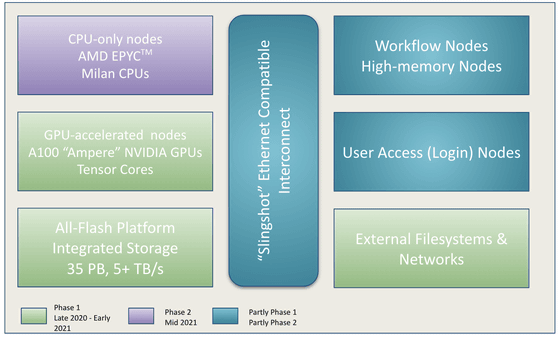The supercomputer 'Perlmutter' equipped with 6159 GPUs 'NVIDIA A100' for data centers is in operation, and the mission is to analyze the mystery 'dark energy' of the universe.

On May 27, 2021, the
Introducing Perlmutter
https://perlmutter.carrd.co/
NERSC Turns on World's Fastest AI Supercomputer | NVIDIA Blogs
https://blogs.nvidia.com/blog/2021/05/27/nersc-perlmutter-ai-supercomputer/
Berkeley Lab Debuts Perlmutter, World's Fastest AI Supercomputer
https://www.hpcwire.com/2021/05/27/nersc-debuts-perlmutter-worlds-fastest-ai-supercomputer/
Nvidia, NERSC claim Perlmutter is world's fastest AI supercomputer | VentureBeat
https://venturebeat.com/2021/05/27/nvidia-nersc-claim-perlmutter-is-worlds-fastest-ai-supercomputer/
The newly launched Perlmutter includes 6159 GPUs 'NVIDIA A100' for data centers that first adopted the next-generation architecture ' Ampere ' announced in 2020, and the CPU 'AMD EPYC 7763' (commonly known as AMD EPYC 7763) for servers announced in March 2021. Milan) 'is equipped with about 1500 units and achieves a performance of 60 PFLOPS in high performance computing (HPC) using double precision floating point numbers (FP64). In addition , certain programs such as Quantum Espresso and Berkeley GW can achieve double peak performance. In addition, in the second half of 2021, a CPU node consisting only of 'AMD EPYC 7763' will be added.

Perlmutter bears the name of 2011 Nobel Prize in Physics award-winning astrophysicist

So far, NERSC has operated a supercomputer 'Cori ' with a peak performance of about 30 PFLOPS equipped with 2388 'Intel Xeon Haswell' and 9688 'Xeon Phi', but Cori has been operating 'until 2022'. The situation that is said to 'continue'. It is unclear how supercomputers bearing the name of female Nobel laureate Gerty Cori will be treated after 2022.
Related Posts:







